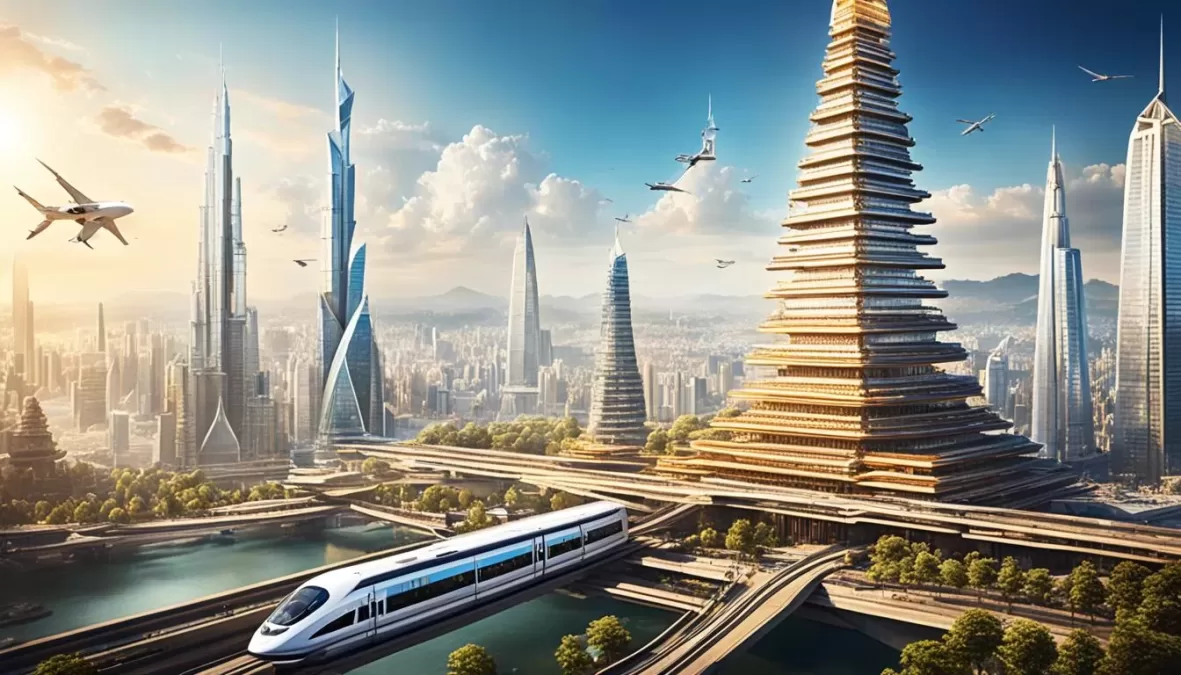India is a powerhouse with the world’s fifth-largest economy and over 1.4 billion people. It’s now the most populous country, surpassing China. Recently, it held the biggest democratic elections, with 642 million votes cast. The new government aims for 8% GDP growth yearly and a $19 trillion GDP by 2047.
They also plan to create 90 million jobs by 2030 and 600 million by 2047. Plus, they’ll invest $600 billion yearly to go net-zero by 2050. Achieving these goals will need hard work from everyone in India’s economy and society.
Key Takeaways
- India is the world’s fifth-largest economy and home to a population of over 1.4 billion people, the largest in the world.
- The Indian government has set ambitious economic goals, including 8% annual GDP growth and $19 trillion GDP by 2047.
- India plans to create 90 million jobs by 2030 and 600 million jobs by 2047, as well as invest $600 billion annually to become net-zero by 2050.
- Technological advancements and innovation will play a pivotal role in India’s future economic progress.
- Achieving these targets will require coordinated efforts from various stakeholders across India’s economy and society.
India’s Promising Economic Growth Projections
The Indian economy is set for amazing growth in the next few years. The government has set big targets in its budget. They aim for an 8% GDP growth each year for the next decade. This will make India’s GDP a huge $19 trillion by 2047.
Achieving 8% GDP Growth and $19 Trillion Economy by 2047
This big goal would make India a top economic power worldwide. Last year, India’s GDP grew by a strong 8.15% from the year before. Experts think India’s GDP will grow between 7% and 7.2% in the next two years. This shows India’s economy is doing well.
Creating 90 Million Jobs by 2030 and 600 Million Jobs by 2047
The government also has big plans for jobs. They want to create 90 million jobs by 2030 and 600 million by 2047. These jobs will help use India’s large and young population well. By 2030, India will have more people than China.
To reach these goals, everyone in India must work together. This means making smart investments, changing policies, and focusing on new ideas and skills. With these efforts, India can look forward to a bright and prosperous future.
Technological Advancements Driving Innovation
India’s future is tied to its tech skills. Digital changes help fast-growing companies in India. They make processes smoother and improve skills in areas like pricing and decision-making.
Unleashing the Potential of Digital and Data
India has seen a big digital change in recent years. It moved from the 155th spot to the top in mobile data use, thanks to Reliance Jio. Digital transactions per person went from 2.4 million in 2014 to 22.4 million in 2019.
This is a tenfold increase in five years. Experts think digital transactions could hit 220 million by 2021, another big jump.
Fostering a Thriving Start-up Ecosystem
India has the world’s third-biggest start-up scene. It offers great chances for start-ups and global centers to work together and speed up innovation. These centers are now making more money and growing into new areas like legal and marketing.
This partnership is pushing India’s innovation forward and making it a key place for tech growth.
“Over 85% of organizations find adopting new and frontier technologies as their primary change-driver.”
India is set to lead in new tech like 5G, AI, and green energy. These advances will boost the economy and help create a better, more inclusive future.
Future of India by 2030 Prediction: Environmental Sustainability Goals
India has big plans for the environment by 2030. The goal is to move to a net-zero future by 2050. This is important for the country, as it’s the third-biggest emitter of greenhouse gases. Experts say going green could bring more benefits than challenges, thanks to India’s strong growth.
Transitioning to a Net-Zero World by 2050
At COP26 in 2021, India made a big promise: to be a net-zero emitter by 2070. To do this, it needs to change its energy use and embrace new green tech. Here are some key steps:
- Scaling up green hydrogen production could cut carbon emissions by 900 megatons by 2050.
- Using carbon capture, utilization, and storage (CCUS) tech can lower industrial emissions.
- Investing in natural climate solutions like reforestation can remove 640 MtCO2e annually by 2050.
Adopting Green Hydrogen and Carbon Capture Technologies
India aims to make five million tonnes of green hydrogen by 2030. This can help clean up hard-to-reduce sectors. Also, CCUS tech is key to cutting emissions in cement, steel, and chemicals industries.
| Emission Reduction Potential | Annual Abatement by 2050 |
|---|---|
| Green Hydrogen | 900 MtCO2e |
| Carbon Capture, Utilization, and Storage (CCUS) | Significant reduction in industrial emissions |
| Natural Climate Solutions (Reforestation, Agroforestry) | 640 MtCO2e |
To meet these goals, India needs to keep investing in clean energy and improve its policies. Working together with the world is also crucial. The path to a net-zero emissions future is tough, but India can lead in green hydrogen and carbon capture tech with effort.
Social Development Initiatives for Inclusive Growth
India’s economic growth has led to big plans for social development. These plans aim to make the economy more inclusive and empower people. A McKinsey study found that 77% of Indians, or over a billion people, live below the economic empowerment line. This means they can’t meet basic needs or be financially secure.
This is the biggest gap in empowerment among G20 countries. India is tackling this challenge with a wide-ranging approach. The main strategies include:
- Investing in digital and data capabilities to streamline processes and enhance decision-making
- Reallocating resources with agility to focus on fast-growing, profitable segments
- Investing in developing the next generation of leaders to enhance operational efficiency and drive innovation
These efforts could lift about 700 million people above the economic empowerment line by 2030, says McKinsey. The private sector’s help is key. They provide capital, technology, mentorship, incubation, and partnerships. This helps create solutions that drive social innovation and progress.
“Collaboration efforts between stakeholders are essential for achieving Sustainable Development Goals (SDGs) by 2030.”
As India aims to become a $19 trillion economy by 2047, these social initiatives are crucial. They ensure inclusive growth and a prosperous future for everyone.

Political Reforms and Governance Strategies
India aims to grow its economy by 8% each year for the next decade. It wants to increase its GDP to $19 trillion by 2047. To achieve this, the government is focusing on key reforms and strategies.
Improving the ease of doing business in India is a major goal. The country has moved up to 63rd place in the World Bank’s Ease of Doing Business ranking in 2020. The “Make in India” policy has also boosted investment, innovation, and infrastructure.
The government is working to include more people in the economy. It’s doing this through skill development programs and supporting entrepreneurship. These efforts aim to create jobs and grow incomes for those who need it most.
| Indicator | Current Status | Projected by 2030 |
|---|---|---|
| India’s GDP | $3.4 trillion (5th globally) | $10 trillion |
| Annual GDP Growth Rate | 6% over the next 5 years | 8% (targeted) |
| FDI Inflows | $84.8 billion in FY 2022 | Continued Increase |
| Women’s Labor Force Participation | 32.8% | Increased Participation |
These reforms and strategies, along with social development, are key for India’s economic success. They create an environment that encourages investment, innovation, and growth for everyone. By doing this, India is set to become a global economic leader by 2030.
Demographic Shifts and Skill Development Programs
India is facing big changes as it moves towards 2030. It has a young population with a median age of 27.6. But, it’s not fully using this young age group’s potential. The labor force participation rate was only 55.2% in 2022, with women at 32.8%. To grow the economy, it’s key to improve skills and get more women into the workforce.
Leveraging India’s Young Population and Talent Pool
India has a huge young market, making it a big opportunity. It leads the world in STEM graduates, with 2.14 million added each year. Women make up 47.1% of these STEM graduates, showing India’s strong female talent.
Upskilling Workers and Increasing Labor Participation
To make the most of its young people, India needs to improve skills and get more women working. Private spending has grown fast, at 11.3% a year, showing more people could be part of the economy. But, the manufacturing sector is struggling with job growth due to new technology. Training programs are vital to get workers ready for new jobs and help India’s young people boost the economy.
| Metric | Value |
|---|---|
| Female Labor Force Participation Rate | 32.8% |
| STEM Graduates (Annual Increase) | 2.14 million |
| STEM Women Graduates | 47.1% |
| Private Final Consumption Expenditure (CAGR) | 11.3% |
| Nominal GDP Growth Rate | 10.6% |

“India has the largest pool of Science, Technology, Engineering, and Mathematics (STEM) graduates globally, with an annual increase estimated at 2.14 million graduates.”
Infrastructure Development Plans and Logistics Improvements
India is working on big plans to improve its infrastructure and logistics. These efforts aim to make the country a top player in manufacturing. By upgrading transport networks and making supply chains smoother, the government wants to fix old problems. This will help boost India’s manufacturing sector.
Enhancing Manufacturing Competitiveness through FDI
The government is taking steps to make India more competitive and attract more foreign investment. It has launched PLI schemes for 15 sectors like electronics and pharmaceuticals. So far, FDI in manufacturing has jumped 76% to over $21 billion in the last fiscal year.
At the same time, the government is speeding up work on infrastructure and logistics. It has a big plan called the National Infrastructure Pipeline. This plan includes projects worth Rs. 108 trillion (US$ 1.3 trillion) across various sectors like power and roads.
- India’s logistics market is expected to hit US$ 484.43 billion by 2029, growing at 8.8% annually.
- FDI in construction and infrastructure sectors was US$ 26.61 billion and US$ 33.91 billion from April 2000 to March 2024.
- The government has given a lot of money to the Ministry of Roads and Railways for 2024-25. This is 5.8% more than last year.
These efforts to improve india infrastructure development, make india logistics improvements, and bring in india fdi in manufacturing will open up new growth paths. They will also help India become a key player in global manufacturing.
Innovation Ecosystems and Global Capability Centers
India’s start-up scene is the third-largest in the world, offering great chances for start-ups and global capability centers (GCCs) to work together. This partnership helps start-ups by giving them market access, connections with big companies, advice, and funding. GCCs get to use new technology quickly, innovate faster, and tap into tech talent.
Transitioning to Profit Centers and Revenue Generation
GCCs in India are changing from being just cost centers to making money. They’re looking to make more money and grow into new areas like legal and marketing. This change is thanks to India’s large, skilled workforce, making it a top spot for tech talent. This is a big plus for GCCs.
Reports say India could see 115 new GCCs a year by 2030, up from 70 now. By 2030, the GCC industry in India will have over 4.5 million people, up from 1.9 million now. This shows how important India’s innovation ecosystems and GCCs are for the country’s tech and economic growth.
“GCCs are pivotal in leading transformative business processes and driving business growth globally.”
The GCC sector is seeing big changes. These include setting up Centers of Excellence (CoEs) in tech areas, moving from cost to profit centers, and adding new functions like legal and marketing. They’re also focusing more on what makes working for them great. These changes show how GCCs in India are evolving and helping the country’s tech talent scene.
Conclusion
India’s future by 2030 looks bright, with big plans for its economy, society, and environment. It aims for 8% GDP growth and 90 million new jobs. It also plans to go net-zero by 2050 and improve economic equality and empowerment.
Reaching these goals will need hard work and teamwork from the government, businesses, and civil groups. With its young people, growing start-ups, and global centers, India could become a major economic force. It could lead in sustainable development worldwide.
Looking at the main points from this detailed study on India’s future, I feel hopeful. India’s use of its young population, tech growth, and green efforts will be key. These will help shape its journey to become a top economic and innovation center by 2030.





